
June 10, 2025* | Case Study | 9 minute read

June 10, 2025* | Case Study | 9 minute read
Materials science helps elevate the game, the experience and sustainability in sports stadiums.
Sustainability is a priority in many sectors, and the world of sports is no exception. Sports organizations are increasingly adopting sustainable solutions to reduce their carbon footprint and enhance energy efficiency. This shift is accelerated by the realization that sustainable practices not only benefit the environment but can also enhance the fan and player experience.
In this evolving landscape, materials play a critical role. By leveraging our advancements in materials science, Dow contributes to sustainable sports facilities. Materials science, an interdisciplinary field, explores how to design materials with specific properties. This expertise enables our teams to develop solutions that meet the unique demands of athletes and where they play.
From the ground up, Dow materials are at the forefront of driving sustainability in sports. These innovations help organizations achieve their sustainability goals, providing durable, high-performance solutions that address environmental impact and elevate the overall experience of venues.

Athletic fields, tracks and courts made with advanced materials can deliver the right combination of performance, strength, and sustainability—ensuring a top-tier playing experience across every sporting pursuit.
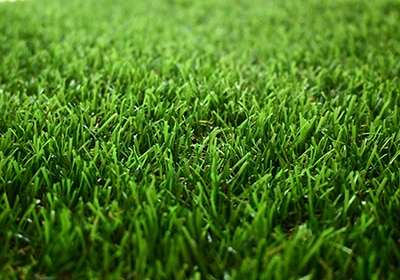 Artificial turf has revolutionized the way sports are played, providing a versatile and durable playing surface for a wide range of activities. From football to field hockey and beyond, artificial turf is the go-to choice for stadiums seeking a reliable and high-performance surface. The benefits of artificial turf extend beyond its immediate functionality; it also offers significant, sustainable advantages.
Artificial turf has revolutionized the way sports are played, providing a versatile and durable playing surface for a wide range of activities. From football to field hockey and beyond, artificial turf is the go-to choice for stadiums seeking a reliable and high-performance surface. The benefits of artificial turf extend beyond its immediate functionality; it also offers significant, sustainable advantages.
One of the environmental benefits of artificial turf is the reduction in water usage. Unlike natural grass, artificial turf requires no regular watering, which conserves vast amounts of water over its lifespan. Additionally, the maintenance of artificial turf is much less resource-intensive than that of natural grass. There is no need for mowing, fertilizing or pesticide application, which reduces both emissions and product runoff.
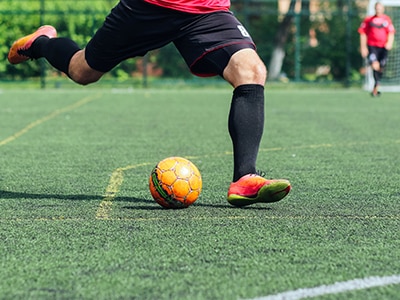 Dow plays a role in advancing artificial turf technology through our innovative materials. Our ELITE™ and DOWLEX™ polyethylene resins are used in the turf yarn, providing a combination of mechanical toughness, softness, and resilience. These properties ensure that players can safely slide, tackle and fall on the surface. Polyurethane can be used to improve strength and durability of turf backing while elastomer materials can be used as an alternative to crumb rubber as infill to cushion players.
Dow plays a role in advancing artificial turf technology through our innovative materials. Our ELITE™ and DOWLEX™ polyethylene resins are used in the turf yarn, providing a combination of mechanical toughness, softness, and resilience. These properties ensure that players can safely slide, tackle and fall on the surface. Polyurethane can be used to improve strength and durability of turf backing while elastomer materials can be used as an alternative to crumb rubber as infill to cushion players.
We are committed to developing sustainable solutions and this is exemplified by our development of REVOLOOP™ 30-LL E Recycled Plastics Resin. This resin, containing 30% post-consumer recycled (PCR) content, is specifically designed for turf applications. It helps sports venues get closer to their sustainability goals by incorporating circular materials to help reduce the overall environmental impact of playing surfaces.
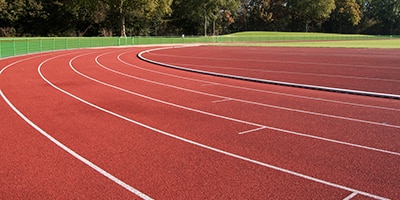 Track materials have transformed the way athletic tracks are built and utilized, providing durable and sustainable solutions that cater to the rigorous demands of athletes. One of our innovations in this arena is DIAMONDLOCK™ Track technology.
Track materials have transformed the way athletic tracks are built and utilized, providing durable and sustainable solutions that cater to the rigorous demands of athletes. One of our innovations in this arena is DIAMONDLOCK™ Track technology.
DIAMONDLOCK™ Track is a high-performance, waterproof sandwich system specifically designed for athletic tracks. Utilizing a sophisticated polyurethane binder system, it delivers top-tier performance across diverse climates, ensuring consistent reliability regardless of location.
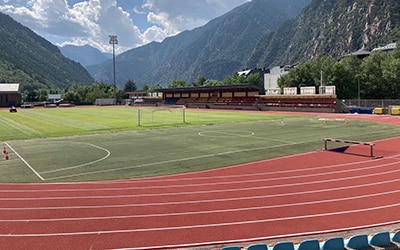 This advanced technology not only enhances the durability of the track but also supports sustainability. More than 60% of DIAMONDLOCK™ Track’s base layer weight is derived from circular materials, effectively giving a second life to materials originally made for other applications. This use of repurposed materials supports sustainable practices in stadiums and reduces the overall environmental footprint of track surfaces.
This advanced technology not only enhances the durability of the track but also supports sustainability. More than 60% of DIAMONDLOCK™ Track’s base layer weight is derived from circular materials, effectively giving a second life to materials originally made for other applications. This use of repurposed materials supports sustainable practices in stadiums and reduces the overall environmental footprint of track surfaces.
An example of DIAMONDLOCK™ Track in action can be found at the Joan Samarra Vila Communal Stadium in Andorra. Installed by Sportan, this track system exemplifies how materials can deliver exceptional performance while adhering to rigorous sustainability standards.
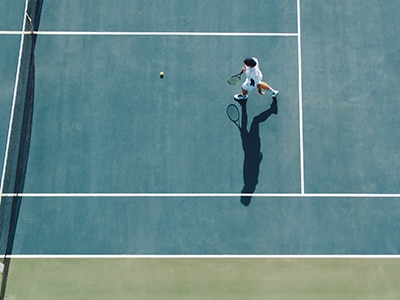 The push for the increased sustainability of playing surfaces has led to advancements in constructing long-lasting hard courts, like those used in tennis.
The push for the increased sustainability of playing surfaces has led to advancements in constructing long-lasting hard courts, like those used in tennis.
Our family of RHOPLEX™ Acrylic Emulsions, used in both indoor and outdoor hard court coatings, helps achieve a balance between performance and sustainability—creating resilient surfaces that withstand tough shots. These emulsions dry quickly, reducing court downtime and increasing facility efficiency. They also resist weather and UV degradation, extending the life of a court and reducing the resources needed to maintain it.
We have also worked with B.T. Sports to develop GreenPave® PermeaCourt, a permeable hard court surface to address the issue of rain disruption in tennis matches. Science plays a crucial role in this innovation through materials and design that enable courts to drain water quickly, reducing the time to dry off after rainfall.
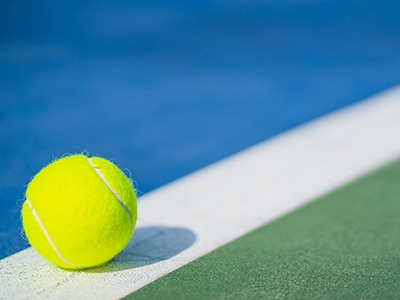 The aggregate-mix surface is made of a series of layers. As the water goes into deeper layers, bigger air spaces continue to force water downward. This inverted-funnel design prevents clogging and maintains permeability, speeding up the drying process and ensuring consistent performance. Our ECOGROUND™ technology further enhances the court surface as a protective coating with outstanding durability and UV resistance.
The aggregate-mix surface is made of a series of layers. As the water goes into deeper layers, bigger air spaces continue to force water downward. This inverted-funnel design prevents clogging and maintains permeability, speeding up the drying process and ensuring consistent performance. Our ECOGROUND™ technology further enhances the court surface as a protective coating with outstanding durability and UV resistance.
A full-scale court using GreenPave® PermeaCourt technology is on display at SportsSG’s Jurong West Centre in Singapore. The International Tennis Federation certified this court as a Level 3 playing surface, and the Singapore Green Building Council also granted its highest certification to this surface system for its sustainable attributes.
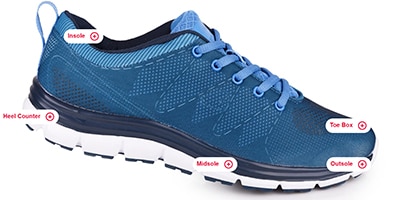 For ultimate performance, athletic footwear is often made with multiple materials, including leather, rubber, foam, polymers, natural textiles and synthetic materials. Each has properties that contribute to the functionality of the shoe and how it interacts with playing surfaces.
For ultimate performance, athletic footwear is often made with multiple materials, including leather, rubber, foam, polymers, natural textiles and synthetic materials. Each has properties that contribute to the functionality of the shoe and how it interacts with playing surfaces.
We collaborate with leading footwear manufacturers to help them create high-performance athletic footwear. For example, midsoles made with Dow INFUSE™ Olefin Block Copolymers offer exceptional recovery and compression, contributing to stability and shock absorption for injury reduction. ENERLYTE™ Polyurethane Elastomers, used in insoles and midsoles, provides lightweight energy return to enhance rebound. And the flexible properties of VORALAST™ Polyurethanes helps shoes perform like day one, every day.
By maintaining precision control and improving the overall efficiency of facility systems, material science contributes to significant energy savings and the sustainability of sports venues.
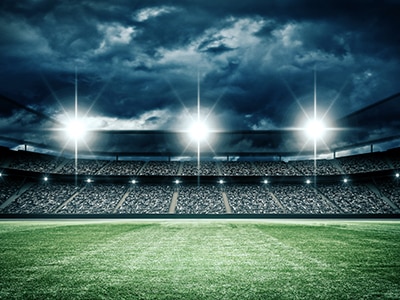 Energy-efficient stadium lighting systems have become a crucial element in reducing electricity consumption while maintaining optimal performance.
Energy-efficient stadium lighting systems have become a crucial element in reducing electricity consumption while maintaining optimal performance.
Advancements in lighting systems include the integration of Dow SILASTIC™ Moldable Optical Silicones in next-generation LED designs. This innovative material opens new avenues for efficiency, light output and energy savings, setting the stage for expressive stadium designs with enhanced visual appeal that also provide a superior visibility experience for both players and spectators.
By optimizing the light distribution and reducing energy consumption, these LED systems contribute cost savings and environmental benefits, supporting the sustainability of modern venues.
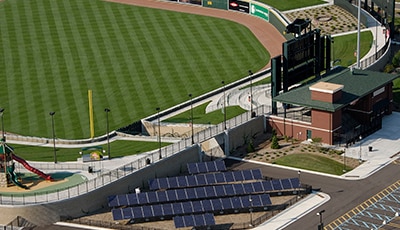 We have collaborated on the enhancement of stadium lighting at the Dow Diamond, home of the Great Lakes Loons, a Minor League Baseball team affiliated with the Los Angeles Dodgers. The upgrade involved installing a state-of-the-art LED lighting system with improved light levels, uniformity, glare control, and energy efficiency, as well as special effects capabilities.
We have collaborated on the enhancement of stadium lighting at the Dow Diamond, home of the Great Lakes Loons, a Minor League Baseball team affiliated with the Los Angeles Dodgers. The upgrade involved installing a state-of-the-art LED lighting system with improved light levels, uniformity, glare control, and energy efficiency, as well as special effects capabilities.
Alongside Schréder, we also developed reliable LED floodlights to illuminate the 6,000-seat Hidegkuti Nándor Stadium in Hungary under intense conditions and UV exposure—introducing Eastern Europe’s first LED-illuminated sports stadium.
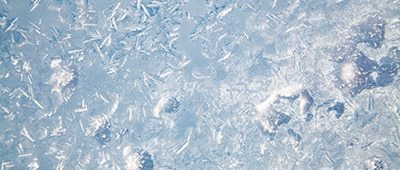 In ice venues, heat transfer fluids are used to enable precision control of temperatures to create rinks tailored to the specific needs of different sports, like hockey or speed skating.
In ice venues, heat transfer fluids are used to enable precision control of temperatures to create rinks tailored to the specific needs of different sports, like hockey or speed skating.
The movement of steel skate blades and other equipment releases energy that can soften ice and slow down athletes. Heat transfer fluids are a material that helps transfer heat from one part of a system to another. In rinks, these fluids are used to maintain the exact temperature needed to ensure athletes have the proper grip on the surface of the ice.
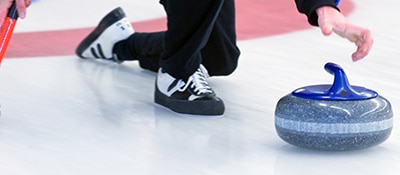 DOWTHERM™ SR-1 Heat Transfer Fluid is chilled by refrigeration equipment beneath the rink and then circulated through a network of pipes. The cold solution extracts any heat collecting on the floor, causing a layer of water to freeze into a smooth sheet of ice. The fluid is then circulated back to the refrigeration system where the heat is dissipated.
DOWTHERM™ SR-1 Heat Transfer Fluid is chilled by refrigeration equipment beneath the rink and then circulated through a network of pipes. The cold solution extracts any heat collecting on the floor, causing a layer of water to freeze into a smooth sheet of ice. The fluid is then circulated back to the refrigeration system where the heat is dissipated.
With DOWTHERM™ Heat Transfer Fluids’ unmatched ability to maintain temperatures, the technology helps ease maintenance requirements and protects pipes from corrosion.
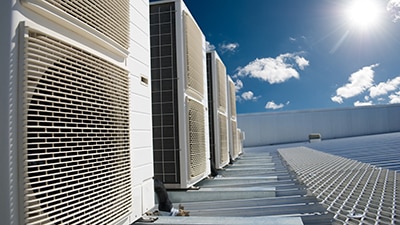 Heat transfer fluids are used in stadium HVAC (heating, ventilation, and air conditioning) systems to improve energy efficiency in heating and cooling of the facility.
Heat transfer fluids are used in stadium HVAC (heating, ventilation, and air conditioning) systems to improve energy efficiency in heating and cooling of the facility.
High-quality heat transfer fluids can enable HVAC systems to perform for 20 years or more by protecting system components against corrosion and scaling that can lead to costly system downtime. Efficient HVAC systems help large sports facilities, like stadiums, reduce their operational costs and environmental impact.
DOWFROST™ Heat Transfer Fluids play a significant role in this function by serving as secondary refrigerants in air conditioning systems. These fluids help optimize air flow throughout the stadium, ensuring that indoor areas remain cool and comfortable for spectators.
Building state-of-the-art stadiums requires sustainable materials and cutting-edge techniques to ensure the longevity and human-centric design of the structures.
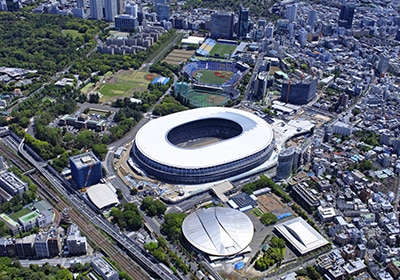 Sustainable construction materials and techniques are pivotal in building modern stadiums. Dow has pioneered innovations that meet the highest standards of performance, enhance the durability of these structures and reduce their environmental impact.
Sustainable construction materials and techniques are pivotal in building modern stadiums. Dow has pioneered innovations that meet the highest standards of performance, enhance the durability of these structures and reduce their environmental impact.
The Japan National Stadium served as the Olympic Stadium during the Olympic Games Tokyo 2020. This main venue for Tokyo 1964 was retrofitted with several Dow technologies in insulation, coatings, paints and wiring for Tokyo 2020. This includes foam sealants to fill gaps between materials and provide structural stability during heat expansion, cable insulation for reliable power throughout the venue, water-based coatings to meet low-VOC requirements, and telecommunications compounds for the seamless transmission of event footage across the world.
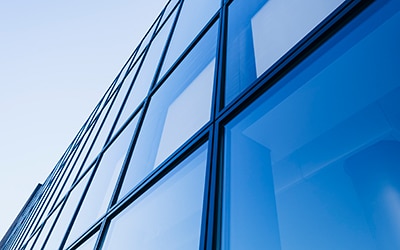 Another example of materials used in stadium construction is DOWLEX™ PE Resins, which help pipes resist stress cracks. DOWSIL™ Silicone Structural Glazing Sealants deliver seamless glass façades that contribute to both the aesthetic appeal and structural integrity of stadiums.
Another example of materials used in stadium construction is DOWLEX™ PE Resins, which help pipes resist stress cracks. DOWSIL™ Silicone Structural Glazing Sealants deliver seamless glass façades that contribute to both the aesthetic appeal and structural integrity of stadiums.
The Dow Center stadium in Bahía Blanca, Argentina, a flexible-use facility supported by Dow and other partners, became the first LEED-certified sports complex in Latin America in 2022. Its construction includes polyisocyanurate panels and SILASTIC™ silicone elastomers to create effective insulation that reduces energy consumption and improves the acoustics of the venue.
In 2019, the Golden State Warriors moved into the Chase Center, a premier facility in San Francisco featuring an 18,000-seat arena and mixed-use office and retail space. The project faced challenges including a tight build schedule and achieving LEED Gold certification. To meet these goals, they teamed up with Dow technical experts to install a DOWSIL™ Silicone Air Barrier System for the damp climate conditions and DOWSIL™ silicone structural sealants for the challenging façade design.
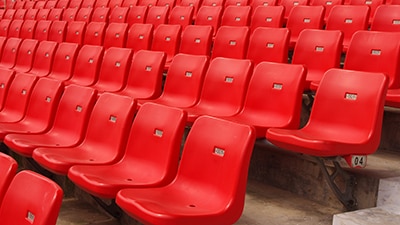 Stadium seating that is sustainable and comfortable is a growing trend. Innovative solutions like the use of recycled materials and modular design are being installed in venues around the world.
Stadium seating that is sustainable and comfortable is a growing trend. Innovative solutions like the use of recycled materials and modular design are being installed in venues around the world.
Dow contributes to this aspect of the fan experience through water-based coatings formulated with acrylic resins, which protect seating from the relentless sun and corrosive elements. Our solutions are also bringing a new level of comfort and support to spectators, ensuring that every game can be enjoyed with ease.

Materials science is transforming the world of sports. By focusing on sustainability, durability, and performance, it is enhancing the experiences of fans and athletes and contributing to the long-term sustainability of stadiums and other venues.
Dow aims to continue pushing the boundaries of what is possible, so that every aspect of the sporting world can benefit from our innovative technologies and solutions.
This case study was developed by a cross-discipline team representing materials expertise across Dow, Inc. To learn more about how Dow is innovating materials that are brought to life through venues, fields of play, apparel and equipment—take a deeper look inside the science of sport.
*This article was originally published Jan 29, 2025